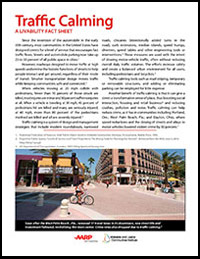AARP Hearing Center
Since the advent of the automobile, most streets in the U.S. have been designed primarily for cars — fast-moving cars. Unfortunately, roadways designed to move traffic at high speeds undermine the historic functions of streets to help people interact and get around.
Traffic calming is a system of design and management strategies that include modern roundabouts, narrowed roads, chicanes (intentionally added turns in the road), median islands, speed humps, diverters, speed tables and other interventions. These measures are used to slow motor-vehicle traffic, often without reducing overall daily traffic volumes. The efforts increase safety and create a balanced urban environment for all users, including pedestrians and bicyclists.
Key Points
Among the data cited in the fact sheet.
- Streets and automobile parking now take up 25 to 50 percent of all public space in cities.
- When vehicles moving at 20 mph collide with pedestrians, fewer than 10 percent of those struck are killed, most injuries are minor and 30 percent suffer no injuries at all. When a vehicle is traveling at 30 mph, 45 percent of pedestrians hit are killed and many are seriously injured; at 40 mph, more than 80 percent of the pedestrians involved are killed and all are severely injured.
- Our roads are especially hazardous for children, low-income people and older adults. Even though older adults are 13 percent of the U.S. population, they were 20 percent of pedestrian fatalities in 2011.
Success stories are provided from Florida (West Palm Beach), North Carolina (Hendersonville) and California (San Francisco):
- After narrowing a former state highway to two traffic lanes with widened sidewalks, downtown Hendersonville, North Carolina, became more pedestrian-friendly, especially for the one out of four town residents who are retired. When the highway was rerouted to adjacent streets and the Main Street improvements were completed, Hendersonville’s retail vacancies dropped from 14 to one.
- In West Palm Beach, traffic calming was initially used as a response to resident complaints about speeding and cut-through motor vehicle traffic. The city found that driver behavior improved, which led to an increase of pedestrians, cyclists and skaters, which led to a substantial crime reduction. Residents and businesses invested more than $300 million in renovations and improvements, increasing property values and business receipts, neighborhood pride and tourism.
How to Use
Because the fact sheets in the Livability series are only four pages each, the materials are quick and easy to read online or to download and print for sharing.
The Traffic Calming fact sheet can be used by policy makers, transportation planners, community leaders and citizen activists to educate themselves and others about the neighborhood benefits of slowing down.
Fact sheet published Spring 2014




























































